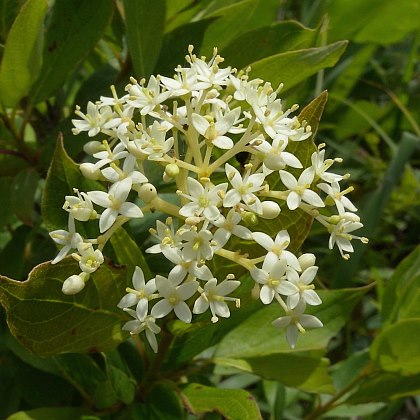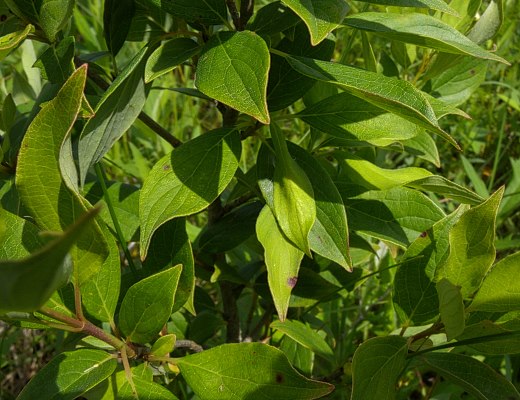Description: This shrub is 3-8' tall, erect, and abundantly branched. The bark of older branches is gray or gray-brown and slightly roughened from the abundant small lenticels. Young stems are pale green, yellowish green, or red; they are devoid of hairs. Opposite leaves up to 4" long and 1½" across occur at intervals along these stems; they are lanceolate to ovate and smooth along their margins. The upper leaf surfaces are medium green, yellowish green, or reddish green, while their lower surfaces are pale green; sparse appressed hairs are sometimes present on both the upper and lower leaf surfaces. Leaf venation is pinnate; there are typically 3-4 curved lateral veins on either side of the central vein on each leaf. The leaf bases are rounded to wedge-shaped (usually the latter), while their tips are long and slender. The slender petioles are up to ¾" long.

Occasionally, dome-shaped panicles of flowers are produced; they are about 1½–2½" across and about as tall. Individual flowers are about ¼" across, consisting of a short calyx with 4 small teeth, 4 white lanceolate petals, 4 stamens with pale yellow anthers, and a central pistil. The branches of the panicle are hairless and cream-colored when the flowers are produced; later they become bright red when the fruit matures. The blooming period occurs from late spring to midsummer and lasts about 3 weeks. The flowers are replaced by globoid drupes about ¼" across that become white at maturity. Each fleshy drupe contains 1-2 furrowed seeds. The root system can produce clonal offsets from underground runners; this can result in a thicket of small shrubs.
Cultivation: This shrub prefers partial to full sun and moist to mesic conditions; it tolerates a wide range of soil types, including soil that is loamy and rocky.
Range & Habitat: The native Gray Dogwood has been found in most counties of Illinois; it is a common shrub. Habitats include open woodlands and woodland openings, savannas, prairies, limestone glades, thickets, fence rows, abandoned fields, powerline clearances, and roadsides. In wooded areas, this shrub tends to spread in response to wildfires and selective logging of trees. It is found in both high quality and degraded habitats (more often, the latter).
Faunal Associations: The nectar and pollen of the flowers of Gray Dogwood attract a variety of insects, including bumblebees, honeybees, cuckoo bees (Nomada), Halictid bees (including green metallic bees), masked bees (Hylaeus), Andrenine bees (including the oligolege, Andrena fragilis), Sphecid wasps, Eumenine wasps, Syrphid flies, dance flies (Empis), Tachinid flies, flesh flies (Sarcophagidae), blow flies (Lucilia), Muscid flies, butterflies, soldier beetles (Cantharidae), tumbling flower beetles (Mordellidae), and Scarab beetles (Trichiotinus); see Robertson (1929), Krombein et al. (1979), and Lisberg & Young (2003) for more information. Many insects feed on the leaves, plant sap, wood, and other parts of Gray Dogwood and other dogwood shrubs (Cornus spp.). These insect feeders larvae of long-horned beetles, leaf beetles (including the flea beetles, Altica corni & Paria scutellaris), plant bugs (including Lygocoris communis & Plagiognathus cornicola), larvae of gall flies, aphids, leafhoppers, armored scale insects, mealybugs, thrips, larvae of many moths, and larvae of a butterfly, the Spring Azure (Celastrina ladon). The Texas Bush Katydid (Scudderia texensis) has been observed feeding on the leaves of Gray Dogwood. The Insect Table provides a more complete list of these insect feeders. The fruit of Gray Dogwood is eaten by many kinds of birds, including ducks, upland gamebirds, woodpeckers, thrushes, and other songbirds (see Bird Table). Mammals that feed on these shrubs include the White-tailed Deer (twigs, foliage, fruit), White-footed Mouse (fruit/seeds), Deer Mouse (fruit/seeds), Fox Squirrel (fruit/seeds), Cottontail Rabbit (winter bark), and American Beaver (wood, bark). The latter animal uses dogwood branches in the construction of its dams and lodges when these shrubs grow near bodies of water. Because of its dense branching structure and tendency to form thickets, Gray Dogwood is also used by the Gray Catbird, Hooded Warbler, Yellow Warbler, American Woodcock, and other animals for protective cover and nest sites (Bielefleldt & Rosenfeld, 2001; DeGraaf, 2002; Eastman, 1992).
Photographic Location: The Loda Cemetery Prairie in east-central Illinois.

Comments: This small dogwood is sometimes cultivated as a multistemmed shrub. Generally, Gray Dogwood (Cornus racemosa) can be distinguished from other Dogwood shrubs by its dome-shaped panicles of flowers, which are about as tall as they are wide. Other species in this genus produce flat-topped panicles of flowers that are wider than they are tall. Except for Cornus obliqua, the leaves of Gray Dogwood are more slender than those of other Dogwood species. The mature berries of Gray Dogwood are white, rather than pale blue or dark blue-violet. Other species in this genus with white berries include Cornus drummondii (Rough-leaved Dogwood) and Cornus sericea (Red-Osier Dogwood). Rough-leaved Dogwood has leaves that are more hairy and broad than those of Gray Dogwood, and its stems are also hairy, rather than smooth. It is often, but not always, a larger shrub than Gray Dogwood. Red-Osier Dogwood also has wider leaves and its stems are bright red to a much greater extent.